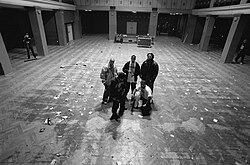Origins
LA Weekly listed Jimmy Spicer's 1980 single "Adventures of Super Rhyme" as the first example of "proto-horrorcore", due to a lengthy segment of the song in which Spicer recounts his experience of meeting Dracula. [10] The group Dr. Jeckyll and Mr. Hyde specialized in horror-themed music. Dana Dane's song "Nightmares" related a frightening narrative. [10]
Since 1986, Ganxsta N.I.P. has performed horror-themed lyrics that he has described as "Psycho Rap", but he was not commonly considered to be horrorcore until the term came into mainstream prominence. [11] Ganxsta N.I.P. has written lyrics for other groups, including Geto Boys, who were also an influence on the early horrorcore sound. [11]
In 1988, DJ Jazzy Jeff & The Fresh Prince released "A Nightmare on My Street", which described an encounter with Freddy Krueger, [10] and the Fat Boys recorded the similarly themed "Are You Ready for Freddy" for the film A Nightmare on Elm Street 4: The Dream Master and its soundtrack. 1988 is also the year Insane Poetry (at the time called His Majesti) released "Armed & Dangerous", followed by their debut single as Insane Poetry, "Twelve Strokes Till Midnight", one of the first examples of music specifically made to be horrorcore. [10] The following year saw the release of Boomin' Words from Hell , the debut album of Detroit-based rapper Esham, who would become particularly influential on Midwest horrorcore (though he rejects the term, preferring "acid rap"). [10]
Although Kool Keith claimed to have "invented horrorcore", [12] the first use of the term appeared on the group KMC's 1991 album Three Men With the Power of Ten . Nonetheless, Kool Keith brought significant attention to horror-influenced hip hop with his lyrical content as a part of the Ultramagnetic MC's and his 1996 debut solo album, Dr. Octagonecologyst .
In 2024, writers at Complex described Nas' 1994, debut studio album, Illmatic , as "shocking, borderline horrorcore (before horrorcore was a genre)". The album showcased Nas's early-'90s style of rap and was credited with generating significant hype for the MC. [13]
Rise in the hip hop genre
The Geto Boys' debut album, Making Trouble , contained the dark and violent horror-influenced track "Assassins", which was cited by Violent J of the horrorcore group Insane Clown Posse in his book Behind the Paint as the first recorded horrorcore song. He writes that the Geto Boys continued to pioneer the style with their second release, Grip It! On That Other Level , with songs such as "Mind of a Lunatic" and "Trigga-Happy Nigga". [14] The Geto Boys' 1991 album, We Can't Be Stopped , was also influential on the horrorcore genre and contained themes of paranoia, depression, and psychological horror, especially in the track "Chuckie", and "Mind Playing Tricks on Me". [15] [16]
While rappers in the underground scene continued to release horrorcore music, including Big L, [17] Insane Poetry, [18] and Insane Clown Posse, [10] the mid-1990s brought an attempted mainstream crossover of the genre. [10]
According to the book Icons of Hip Hop, horrorcore gained mainstream prominence in 1994 with the release of Flatlinerz' U.S.A. (Under Satan's Authority) and Gravediggaz' 6 Feet Deep (released overseas as Niggamortis). [19] [20] [21] [22] The Flatlinerz and Gravediggaz, along with the Geto Boys, Insane Clown Posse and Kool Keith, remain the most important artists in the development of horrorcore as a specific genre.
In 1995, an independent horror film called The Fear was released with a soundtrack consisting entirely of horrorcore songs, including Insane Clown Posse's biggest radio hit, "Dead Body Man" and a title track ("The Fear (Morty's Theme)") by Esham. [10] 1995 also saw the release of Three 6 Mafia's debut album, Mystic Stylez , which touched on heavy drug use, ritualistic sex, mass murder, torture, and Luciferianism. Bone Thugs-N-Harmony's E. 1999 Eternal , released in the same year, contains tales of the occult throughout, specifically on songs such as "Mr. Ouija 2", "Mo' Murda", "East 1999", and "Da Introduction". Tension would soon rise between Bone Thugs and Three 6 over their presumed similarities in style and use of dark imagery.
In 2009, dark music-themed website Fangoria named Tech N9ne's 2001 album Anghellic as an iconic and influential album to the genre, the artist, and hip-hop as a whole.
Horrorcore is generally not popular with mainstream audiences, though in some cities, like Detroit, it is the dominant style of hip-hop, with Detroit-based performers such as Insane Clown Posse [23] and Eminem, [24] as well as Twiztid, having been commercially successful throughout the US. [19] Horrorcore has thrived in Internet culture. Every Halloween since 2003, horrorcore artists worldwide have gotten together online and released a free compilation titled Devilz Nite. [25] According to the January 2004 BBC documentary Underground USA, the subgenre "has a massive following across the US" and "is spreading to Europe". [26] Rolling Stone in 2007 referred to it as a short-lived trend that generated "more shlock than shock". [21]
